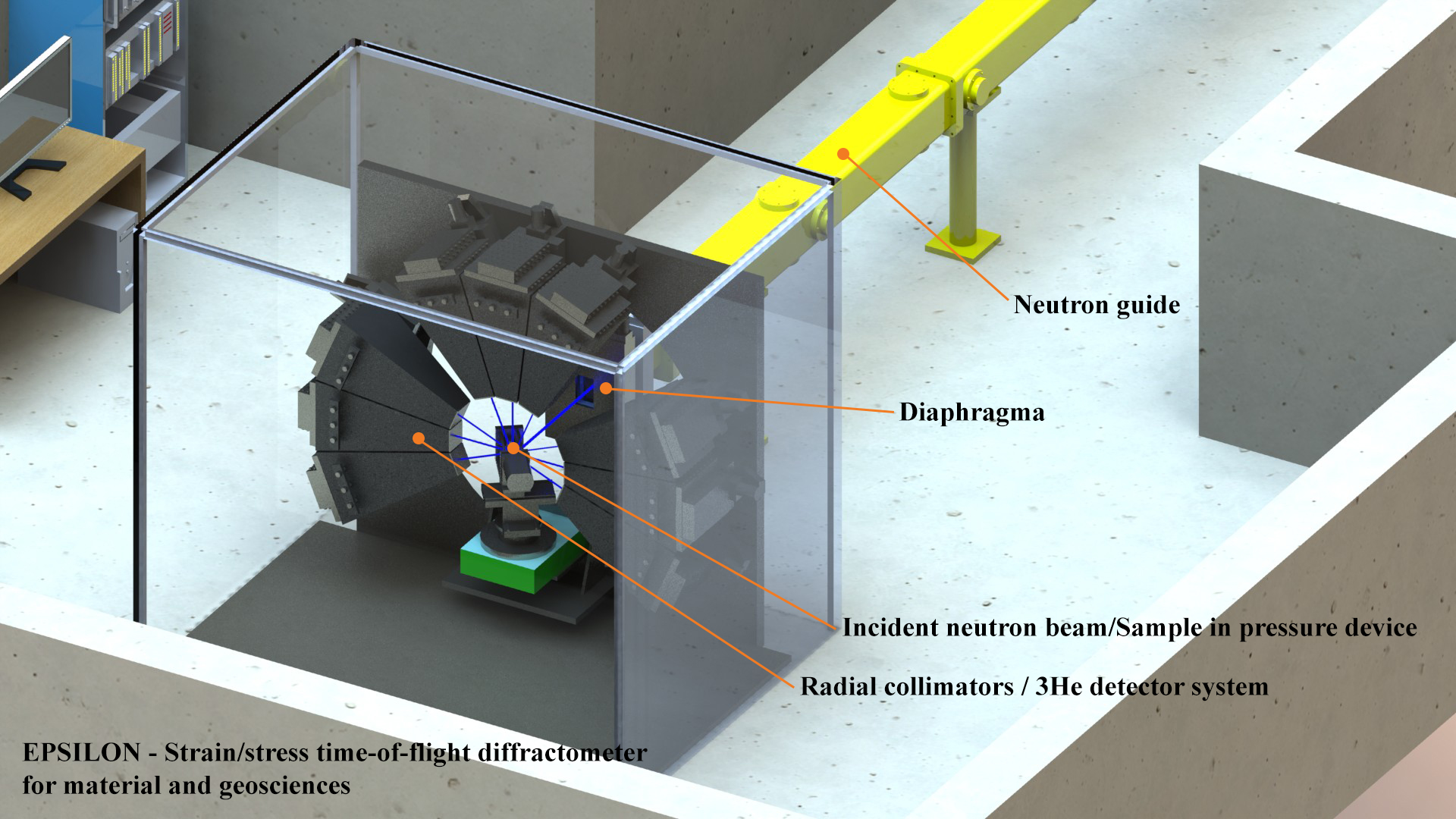Responsible for the facility
Zel Ivan
tel. +7 (49621) 6-30-66
e-mail: This email address is being protected from spambots. You need JavaScript enabled to view it.
Main research areas
Stress, strain and texture measurements in geological, metal and ceramic samples.
Facility layout
Main view of facility
Sample environment
Description of EPSILON
The EPSILON diffractometer is positioned on beamline 7A. The long neutron flight path from the pulsed source (about 107 m) allows to carry out diffraction experiments with a very high resolution. A "white" neutron beam with a wide range of wavelengths is used to study the evolution of strains in polycrystalline materials, including metals, ceramics and geological samples. The main advantage of the diffractometer is the simultaneous detection of a large range of lattice planes, in concern with high resolution. This is essential for the investigation of multiphase materials that contain phases with low crystallographic symmetries, typical of a range of ceramics, technical materials and rocks.
The diffractometer was named EPSILON after the Greek letter e, following the scientific notation for strain. It is equipped with a special detector system: 81 detectors are distributed over nine units that allows one to simultaneously determine the strain in nine areas and in such a way to investigate the spherical strain of polycrystalline materials. Various devices of the sample environment system, such as a single-axis pressure measuring device, allow to determine strains under external load conditions up to 450 MPa that corresponds to a depth of up to 5 km in the Earth's crust. In addition, acoustic emission is additionally detected for the occurrence of microcracks, including their generation, location and propagation. Measurements with an increase in the temperature of samples up to +150°C allow to study thermal strains. It is also possible to rotate a sample under pressure allowing to investigate strains at different crystallographic orientations.
EPSILON is also equipped with a unique 3-way pressure measurement device that allows one to simulate conditions deep in the Earth's crust and in this way helps to better understand the complex processes on our planet. EPSILON has been developed in close cooperation between JINR and the Karlsruhe Institute of Technology, Germany.
Basic parameters Total flight path (moderator-detector) ~107 m λmax 7.1 Å λmax (using beam chopper) 14.4 Å dmax 5.1 Å dmax (using beam chopper) 10.2 Å Neutron guide Cross section: 50 mm (w) × 90 mm (h) Radius: 13400 m Coating: natural Ni (m = 1) Optional: chopper covering every second neutron pulse Detectors: 81 × 3He single tubes Diameter: 10mm Length: 120mm Collimators: length divergence of the foils 2θ-range size of entrance window size of exit window Nine radial collimators with GdO2 coating 500 mm 20' of arc 82° ≤ 2θ ≤ 98° 50 × 50 mm2 200 × 200 mm2 Spectral resolution Δd/d 4 10-3 at d ≥ 2 Å (20' collimation) Goniometer 4 axis F-rotation 0° to 360° Accuracy 0.0025° x-, y- motion 120 mm z-motion 40 mm Accuracy 0.0025 mm and 0.0025°, respectively Single-axis pressure device F = 100 kH (150 MPa) Sample diameter 30 mm Length 60 mm Maximum Sample Volume 42 cm3 Sample positioning using laser beam Experiment control SONIX-VME measuring system on OS-9 and X WINDOW
Sample environment
- single-axis compression up to 150 MPa with the possibility of sample rotation without pressure release
- optical furnace up to 140 ºС. It can be used with a single-axis compression.
- acoustic emission device up to 4 independent beamlines.
- optical extensiometer.
- three-axis compression 150 MPa, 30 MPa, 30 MPa
Publications
1. Walther, K., Scheffzuek, C., Frischbutter, A. (2000). Neutron time-of-flight diffractometer epsilon for strain measurements: layout and first results. Physica B, Condensed Matter 276-278, 130-131.
2. Walter, K., Frischbutter, A., Scheffzük, C., Korobchenko, M., Levchanovski, F., Kirilov, A., Astachova, N.; Murashkevich, S (2005). EPSILON-MDS - a neutron time-of.flight diffractometer for strain measurements. In: Esling, C., Humbert, M., Schwarzer, R., Wagner, F. (Eds.): Texture and Anisotropy of Polycrystals II (ITAP2), trans Tech Publ., Solid State Phenomena 105, 67-70
3. Scheffzük, C., Müller, B. I. R., Breuer, S., & Schilling, F. R. (2018). In situ triaxial deformation experiments on a sandstone sample for strain investigation at the neutron time-of-flight diffractometer EPSILON. In German Conference for Research with Synchrotron Radiation, Neutrons and Ion Beams at Large Facilities, Garching

